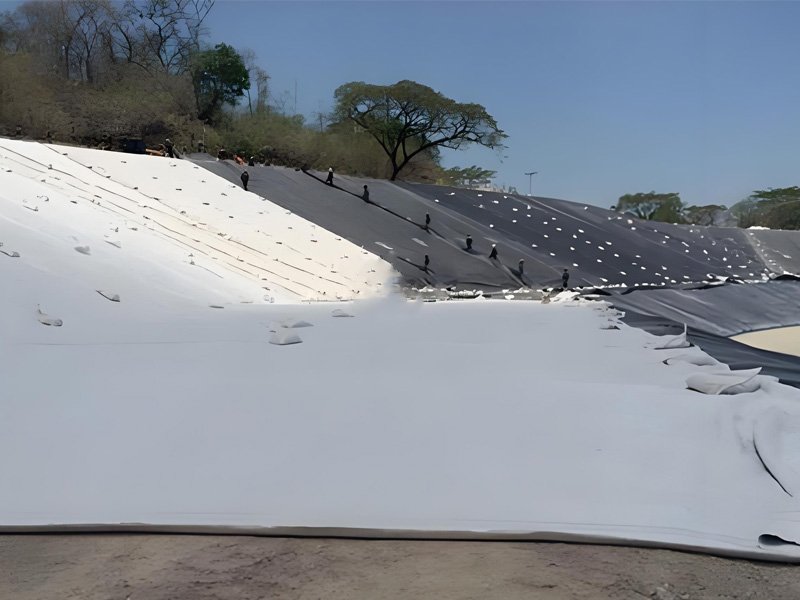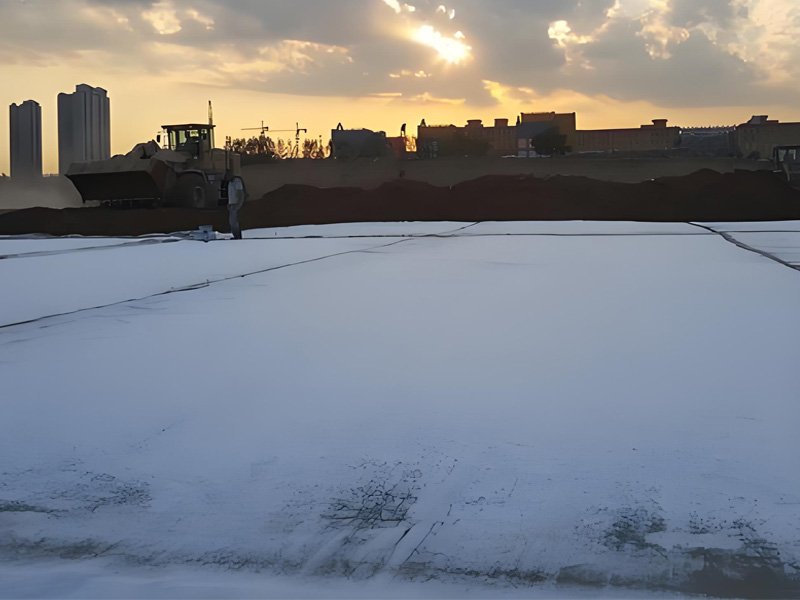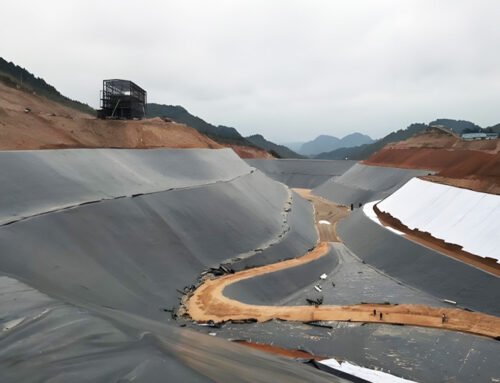Geosynthetic clay Liner is a geosynthetic material specially used for anti-seepage in artificial lake waterscapes, landfills, underground garages, rooftop gardens, pools, oil depots and chemical storage yards. It is composed of highly eSeveral factors can influence the performance and price of geosynthetic clay liners (GCLs) in various applications.Let’s explore BPM Geosynthetics’ product GCL.
1. What is Geosynthetic clay Liner
Geosynthetic clay liners (GCLs) are factory-made hydraulic barriers consisting of a layer of bentonite or other very low permeability material supported by geotextiles and/or geomembranes, mechanically held together by needling, stitching, or chemical adhesives. Bentonite, composed primarily (>70%) of montmorillonite or other swelling clays, is the preferred and most commonly used GCL. Typical GCLs use woven and non-woven textile geosynthetics stitched together to enclose a layer of natural or processed sodium bentonite.
Mechanism And Effect
The main mechanism is to use the impermeability of plastic film to block the leakage channel of earth dam, and to withstand water pressure and adapt to the deformation of dam body with its large tensile strength and elongation; non-woven fabric is also a kind of polymer short fiber chemical material, which has high tensile strength and elongation through needle punching or hot bonding. After it is combined with plastic film, it not only increases the tensile strength and puncture resistance of plastic film, but also increases the friction coefficient of contact surface due to the rough surface of non-woven fabric, which is beneficial to the stability of composite geomembrane and protective layer. At the same time, they have good corrosion resistance to bacteria and chemical action, are not afraid of corrosion by acid, alkali and salt, and have a long service life when used away from light.


2. What Is The Advantage Of Geosynthetic Clay Liner?
2.1 Compactness
Sodium bentonite forms a high-density diaphragm under water pressure. When the thickness is about 3mm, its water permeability is less than &×10ˉ11m/sec, which is equivalent to 100 times the density of 30cm thick clay, and has strong self-water retention performance.
2.2 Permanent waterproof performance
Because sodium bentonite is a natural inorganic material, it will not age or corrode even after a long time or when the surrounding environment changes, so the waterproof performance is long-lasting.
2.3 Easy construction and short construction period
Compared with other waterproof materials, the construction is relatively simple and does not require heating and pasting. Only bentonite powder, nails, washers, etc. are needed for connection and fixing. No special inspection is required after construction, and if waterproof defects are found, they are easy to repair. GCL has the shortest construction period among existing waterproof materials.
2.4 Not affected by temperature
It will not break brittlely even in cold climates.
2.5 Integration
Integration of waterproof materials and objects: Sodium bentonite has an expansion capacity of 20-28 times when it comes into contact with water. Even if the concrete structure vibrates and settles, the bentonite in the GCL can repair cracks on the concrete surface within 2mm.
2.6 Green and environmentally friendly
Bentonite is a natural inorganic material, harmless and non-toxic to the human body, has no special impact on the environment, and has good environmental performance.
3. What Is The Application Of Geosynthetic Clay Liner?
Geosynthetic clay liners (GCLs) are widely used in civil engineering and environmental applications due to their beneficial properties. Some common applications of geosynthetic clay liners include:
- Landfills: GCLs are used as a part of the liner system in landfills to prevent the leachate (contaminated liquid) from seeping into the surrounding soil and groundwater.
- Mining: GCLs are used in mining operations to line tailings ponds and prevent the contamination of groundwater and soil with toxic materials.
- Pond Liners: GCLs are used in the construction of ponds and reservoirs to prevent seepage and retain water.
- Canal Liners: GCLs can be used to line canals, ditches, and channels to prevent water seepage and erosion.
- Road Construction: GCLs can be used in road construction as a part of the road base or subgrade to improve stability and reduce water infiltration.
- Secondary Containment: GCLs are used in secondary containment systems to prevent leaks and spills from hazardous materials storage facilities.
- Erosion Control: GCLs can be used in erosion control applications such as slope stabilization and embankment protection.
Overall, the application of geosynthetic clay liners helps in environmental protection, waste containment, and water conservation in various civil engineering projects.
4. What Factors Influence Geosynthetic Clay Liner Price?
The price of geosynthetic clay liners (GCLs) can be influenced by several factors. Here are some key elements that can affect the cost:
4.1 Geosynthetic Clay Liner Price – Material Quality
The quality and type of clay used in the GCL can significantly impact the price. Higher-quality, more durable clays will generally be more expensive.
4.2 Geosynthetic Clay Liner Price – Geotextile Layers
GCLs typically consist of a layer of clay sandwiched between two geotextile layers. The quality and thickness of these geotextile layers can affect the overall cost.
4.3 Geosynthetic Clay Liner Price – Size and Thickness
Larger and thicker GCLs will generally be more expensive due to the increased material costs.
4.4 Geosynthetic Clay Liner Price – Manufacturing Process
The method used to manufacture the GCL can influence its price. For example, needle-punched GCLs may have different costs compared to those made using other techniques.
4.5 Geosynthetic Clay Liner Price – Supply and Demand
Market conditions, including supply chain disruptions, demand fluctuations, and availability of raw materials, can all impact the price of GCLs.
4.6 Geosynthetic Clay Liner Price – Certifications and Standards
GCLs that meet specific industry standards or certifications may be more expensive due to the additional testing and compliance requirements.
4.7 Geosynthetic Clay Liner Price – Brand and Manufacturer
Different manufacturers may offer GCLs at varying prices based on their brand reputation, warranty, and customer service.
4.8 Geosynthetic Clay Liner Price – Customization:
Customized GCLs designed for specific applications or with special features (such as reinforcement or antimicrobial properties) may come at a higher cost.
4.9 Shipping and Handling:
The cost of transporting and handling large rolls of GCLs can add to the overall price, especially if they need to be shipped over long distances or require special handling.
4.10 Quantity Ordered:
Bulk orders often receive discounts, so the quantity of GCLs ordered can affect the unit price.
4.11 Location:
Regional variations in labor costs, transportation expenses, and local market conditions can also influence the price of GCLs.
Understanding these factors can help buyers make informed decisions when purchasing geosynthetic clay liners for their projects.


5. What Are Installation Steps For Geosynthetic Clay Liner?
Installing a geosynthetic clay liner (GCL) requires careful planning and execution to ensure proper performance and longevity. Here are the general steps involved in the installation process:
5.1 Pre-Installation Preparation
- Site Inspection: Conduct a thorough site inspection to identify any potential issues such as sharp objects, uneven surfaces, or areas prone to erosion.
- Subgrade Preparation: The subgrade should be smooth, compacted, and free of debris. Remove any rocks, roots, or other sharp objects that could puncture the GCL.
- Base Course Installation: If required, install a base course of sand or gravel to provide a stable foundation for the GCL. This layer should be well-graded and compacted.
5.2 Unrolling and Laying the GCL
- Unrolling: Carefully unroll the GCL onto the prepared subgrade. Avoid dragging the material to prevent damage.
- Overlap Joints: Ensure that the seams between sheets of GCL overlap by at least 6 inches (15 cm). This can be done by staggering the joints in a brickwork pattern for additional security.
- Alignment: Align the edges of the GCL sheets to minimize gaps and ensure a snug fit. Use a roller to help press the seams together if necessary.
5.3 Sealing and Securing
- Seam Treatment: Apply a compatible sealant tape along the overlapped seams to create a watertight seal. Some projects may require adhesive bonding instead of just mechanical overlap.
- Anchoring: Secure the edges of the GCL to prevent movement. This can be done using anchor trenches filled with soil, landscaping staples, or other appropriate methods.
5.4 Final Adjustments and Inspection
- Smoothing: Use a soft roller or hand tools to gently smooth out any wrinkles or air pockets in the GCL. Avoid over-compacting as this can damage the material.
- Final Inspection: Conduct a final inspection to ensure there are no tears, punctures, or gaps. Repair any damaged areas immediately using patches of GCL and sealant.
5.5 Covering and Backfilling
- Covering Layer: Depending on the application, cover the GCL with a protective layer such as a geotextile fabric, drainage layer, or another type of liner as specified in the project design.
- Backfilling: If applicable, backfill around the edges of the GCL carefully to avoid dislodging or moving the material. Use granular materials to minimize hydrostatic uplift pressure.
5.6 Post-Installation Considerations
- Monitoring: Regularly monitor the GCL for signs of damage or leakage, especially during the initial phases after installation.
- Maintenance: Follow any maintenance guidelines provided by the manufacturer to ensure the longevity and effectiveness of the GCL.
By following these steps meticulously, you can ensure that your geosynthetic clay liner performs optimally, providing effective containment and protection for your project.
6. Summarize
Choosing the right bentonite liner is very important to the project effect. When making the selection, it is important to consider both price and quality. BPM Geosynthetics had been specialized in delivering one stop Geosynthetics Clay liner and other geosythetics to worldwide customers for over 14 years. In recent years, we had been keeping on investing in technological innovation, manufacturing facilities improvement and turnkey engineering abilities. We had invested 10 million dollars into our manufacturing factory with advanced production lines and optimized manufacturing processes. BPM Geosynthetics clay liner, geomembrane geosythetics and solutions can meet your requirements by our solid technologies and professional staffs.





